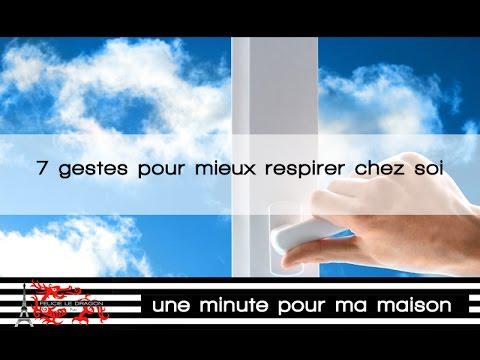[Sustainable Habitat File] If air pollution is no longer ignored today, the enclosed places in which we spend a large part of our life are not spared.Apartment or house, housing is the first concerned with indoor air pollution.
The interior pollution of our homes is an unknown but nevertheless real phenomenon.Indeed, its sources are diverse: coatings, insulation, furniture, heating systems ... They are all the more numerous as one tends to surround themselves with devices and objects not always well maintained and thatMany misconceptions about indoor air.According to the interior air quality observatory (OQAI), the latter would be even more polluted than outside air.In question: volatile organic compounds (VOCs) and other fine particles, also present in the outside air.When you know that we spend almost 80% of our time under a roof, the importance of breathing healthy air at home becomes even more manifest.Here are six gestures that reduce this pollution and breathe new life into its quality of life.
Ventilate
Circulating air in its interior allows you to get rid of fine particles and other dust which, when they reach our body, can alter its good health.As the Ministry of Solidarity and Health indicates, the effects of this interior pollution are diverse: asthma, respiratory allergies, or even irritation of the nose and respiratory tract ... Some substances may even have a carcinogenic effect.It is therefore better to practice ventilation at least twice a day, ten minutes morning and evening for example.Practiced in all rooms in the house, by creating air currents if possible, ventilation will then get rid of the pollutants emitted by most domestic sources.
Watch out for humidity
As humidity grows in an enclosed space, the latter becomes an environment increasingly favorable to the development of molds, which are important factors for the emission of volatile organic compounds (VOCs).Also, humidity retains more pollutants than a dry atmosphere, making suspension particles more difficult to eliminate by ventilation.It is easy to measure the humidity in your accommodation: we will use a hygrometer, analog or electronic.It will then be preferable that it indicates a humidity rate between 40 and 60% for good indoor air quality: above 70%, the space will be considered too wet.A good ventilation, a hygro -relieved ventilation system, avoid extending your laundry inside or temporarily place an humidity absorber are then as many means to reduce humidity in its accommodation.
Station to household or deodorant products ...
Paradoxically, cleaning is one of the main sources of interior pollution.When it comes to getting out of the dirt at home or bad odors, beware of certain products.Indeed, the scented candles and other deodorants in spray give off VOCs, some of which can be very harmful, as are a number of cleaning products.For example, the impact of bleach on our health is often minimized, it can manifest itself by breathing difficulties or nausea, especially among the youngest.Fortunately, the vast majority of these industrial products can be replaced by more natural substances, such as white vinegar, baking soda or black soap, for a result at least equivalent in terms of cleanliness, but also indeodorization terms.

… And to certain construction and decoration products
In fact, almost all that is in our interior is a potential source of pollution.Whether it's floor coverings, walls and ceilings (wallpaper, paint, tiling, carpet, etc.), windows or insulation, these objects or materials emit VOCs that evaporate at room temperature.To see more clearly in the polluting potential of construction and decoration products in contact with indoor air at the time of purchase, there is fortunately a sanitary label, compulsory since 2013. This includes the mention "emissions inindoor air ”and is accompanied by a capital letter ranging from A+ (the best note) to C (the worst).It is therefore the first that we will tend to favor for the healthiest indoor air.
Find all of our file "My sustainable accommodation, user manual" in partnership with Qualitel here!
Adopt the right gestures in the kitchen
In the kitchen, it is the cooking fumes of foods that can be charged with volatile compounds, fine particles and CO2.It is therefore good to think about activating the vacuum hood, covering your pots and other pots and opening the window when possible.According to researchers from the University of Boulder, the simple fact of grilling a slice of bread would emit non-negligible quantities of fine particles.In general, it is advisable to monitor too pronounced cooking, whether in the oven or in the pan, and to ventilate well in the event of an excessive smoke emission.
Maintain your equipment well
Most of our equipment tend to dysfunction if they are poorly maintained.For example, ventilation or heating systems maintained too rarely are condemned to fall into it which transforms them into potential pollution sources.What is more, a dysfunction can be responsible for energy waste, since the device in question will consume so much or more energy for degraded performance.A simple vacuum cleaner on its radiators and a good cleaning of the ventilation system thus makes it possible to widely optimize their performance and limit the diffusion of pollutants.
Since 1974, the Qualitel association has increased, alongside housing professionals, the quality of new and existing housing and participates in its valuation with the occupants.
For this, it exercises 4 additional missions: information from the general public, certification of housing quality and performance, training, evaluation and expertise.It also develops research programs to better understand the problems related to the building and anticipate the technical developments and the expectations of the inhabitants.
In partnership with Qualitel.
Did you appreciate this information ?Subscribe to our newsletter by clicking here!
Pour aller plus loin et agir à votre échelle, découvrez notre guide pratique « Slow Life : mode d’emploi pour ralentir ».
Au sommaire : tout pour entreprendre un passage à une vie plus douce et apprendre à ralentir dans tous les domaines du quotidien.
Pour en savoir plus et commander votre guide, c’est par ici.
#Tousactors








